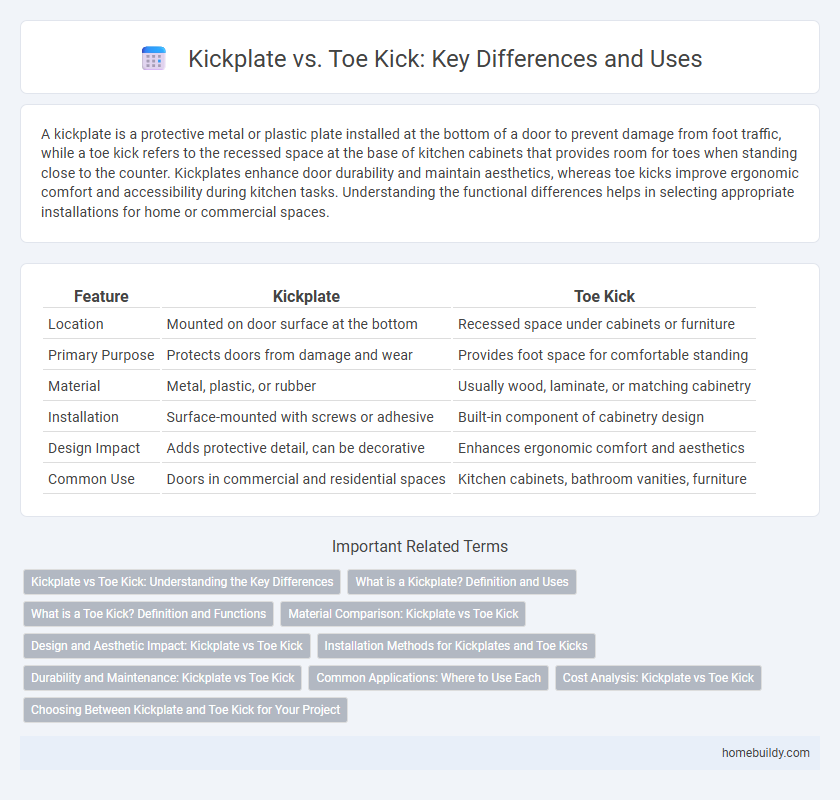A kickplate is a protective metal or plastic plate installed at the bottom of a door to prevent damage from foot traffic, while a toe kick refers to the recessed space at the base of kitchen cabinets that provides room for toes when standing close to the counter. Kickplates enhance door durability and maintain aesthetics, whereas toe kicks improve ergonomic comfort and accessibility during kitchen tasks. Understanding the functional differences helps in selecting appropriate installations for home or commercial spaces.
Table of Comparison
| Feature | Kickplate | Toe Kick |
|---|---|---|
| Location | Mounted on door surface at the bottom | Recessed space under cabinets or furniture |
| Primary Purpose | Protects doors from damage and wear | Provides foot space for comfortable standing |
| Material | Metal, plastic, or rubber | Usually wood, laminate, or matching cabinetry |
| Installation | Surface-mounted with screws or adhesive | Built-in component of cabinetry design |
| Design Impact | Adds protective detail, can be decorative | Enhances ergonomic comfort and aesthetics |
| Common Use | Doors in commercial and residential spaces | Kitchen cabinets, bathroom vanities, furniture |
Kickplate vs Toe Kick: Understanding the Key Differences
Kickplates are protective metal or plastic panels installed on doors to prevent damage from foot traffic, while toe kicks are recessed areas at the bottom of cabinets designed to provide space for feet and improve ergonomics. Unlike toe kicks, kickplates serve a primarily protective function without influencing cabinetry design or comfort. Understanding the distinction helps in selecting the right component for either safeguarding doors or enhancing kitchen usability.
What is a Kickplate? Definition and Uses
A kickplate is a protective metal or plastic plate attached to the lower part of a door to prevent damage from foot traffic, carts, or equipment. Unlike a toe kick, which is a recessed area at the base of cabinets designed to provide space for feet, a kickplate serves primarily as a durable barrier against scuffs and impacts. Commonly found in commercial and high-traffic settings, kickplates extend the lifespan of doors by absorbing wear and tear.
What is a Toe Kick? Definition and Functions
A toe kick is a recessed space at the bottom of a cabinet or countertop designed to provide foot clearance, allowing users to stand closer comfortably while working. Unlike a kickplate, which is a protective plate installed at the base of doors or cabinets, the toe kick primarily enhances ergonomic access and prevents foot strain. Its functional design improves overall kitchen or workspace efficiency by reducing awkward postures during prolonged standing tasks.
Material Comparison: Kickplate vs Toe Kick
Kickplates are typically made from durable materials such as stainless steel, aluminum, or brass, providing strong resistance to impact and scratches. Toe kicks are usually constructed from wood, MDF, or laminate to match cabinetry, offering aesthetic integration but less protection against damage. The choice between kickplate and toe kick materials depends on prioritizing durability and maintenance versus seamless design and cost-effectiveness.
Design and Aesthetic Impact: Kickplate vs Toe Kick
Kickplates offer a sleek, modern design element by providing a protective barrier on cabinet fronts without disrupting the visual flow, enhancing aesthetic appeal with minimalistic style. Toe kicks, traditionally recessed at cabinet bases, create depth and shadow that can add subtle architectural interest but may interrupt clean lines in contemporary kitchens. Choosing between kickplates and toe kicks depends on whether the design prioritizes seamless surfaces or functional depth for foot space.
Installation Methods for Kickplates and Toe Kicks
Kickplates are typically surface-mounted using screws or adhesive for easy installation on doors, providing protection against scuffs and damage. Toe kicks are built into the base of cabinetry or walls, requiring precise measurements and integration during construction or remodel for a seamless finish. Installation methods for kickplates are generally more straightforward and less permanent compared to the recessed and structural installation required for toe kicks.
Durability and Maintenance: Kickplate vs Toe Kick
Kickplates, typically made from durable materials such as stainless steel or aluminum, offer superior resistance to scratches, dents, and moisture compared to traditional wooden toe kicks. Their easy-to-clean surfaces require minimal maintenance, preserving aesthetic appeal and functionality in high-traffic areas. Toe kicks, often crafted from wood or MDF, are prone to damage from water exposure and frequent impact, necessitating regular upkeep and refinishing.
Common Applications: Where to Use Each
Kickplates are commonly installed on doors in high-traffic areas such as commercial buildings, hospitals, and schools to protect surfaces from damage caused by foot traffic and equipment. Toe kicks are primarily found at the base of kitchen cabinets and bathroom vanities, providing ergonomic space for feet while enhancing comfort during prolonged standing. Each serves a distinct functional purpose, with kickplates offering surface protection and toe kicks optimizing user posture and accessibility.
Cost Analysis: Kickplate vs Toe Kick
Kickplates typically cost between $15 and $50 depending on material and size, offering an affordable protective solution for doors and cabinetry. Toe kicks, often integrated into cabinetry design, can increase construction costs by $100 to $300 due to custom fabrication and installation requirements. Evaluating maintenance expenses favors kickplates, which are easier and cheaper to replace compared to modifying or repairing toe kicks.
Choosing Between Kickplate and Toe Kick for Your Project
Selecting between a kickplate and a toe kick depends on the specific functions required in your project. Kickplates, usually made of metal or durable plastic, protect lower cabinet surfaces from scuffs and damage, making them ideal for high-traffic areas. Toe kicks, recessed spaces at the base of cabinets, provide ergonomic comfort by allowing foot space when standing close, enhancing usability in kitchen or workspace design.
kickplate vs toe kick Infographic

 homebuildy.com
homebuildy.com